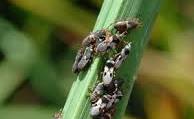How Chinch Bugs Get Into Lawns
- Natural Movement – Chinch bugs are tiny insects (about 1/5 inch long) that can crawl from nearby infested lawns, fields, or grassy areas into your yard. They don’t fly far, but they spread steadily across neighborhoods.
- Eggs in the Soil/Thatch – Female chinch bugs lay eggs in the thatch layer or on grass stems. Lawn may have a thick thatch (dead, matted grass at the soil surface), it provides the perfect environment for them to hatch and thrive.
- Warm, Dry Conditions – Florida’s hot and dry weather, especially in summer, makes chinch bug populations explode. They feed more aggressively when grass is stressed from drought or heat.
- Transport on Equipment – Sometimes, lawn equipment (like mowers, blowers, or trimmers) can move chinch bugs from one yard to another.
- Weakened Turf – Lawns that are stressed by poor watering, compacted soil, low mowing, or nutrient deficiencies are more vulnerable. Chinch bugs are opportunistic and target weak grass first.
Why They’re a Problem
Chinch bugs suck the juices from grass blades, injecting toxins that cause yellowing, browning, and patchy dead spots that spread quickly if untreated. Many homeowners think it’s drought damage at first.
Westfall’s Approach to Solving the Problem:
- Preventative Care – Because chinch bugs can return throughout the warm season, we include preventative treatments in our lawn care programs to keep populations under control.
- Fertilization & Turf Health – Healthy lawns are more resilient. Our customized fertilization program strengthens the root system, improves soil health, and reduces lawn stress—making your grass less susceptible to chinch bug damage.
- Cultural Recommendations – We’ll provide watering and mowing guidance to ensure your lawn stays thick and healthy, creating an environment where chinch bugs are less likely to cause damage.


